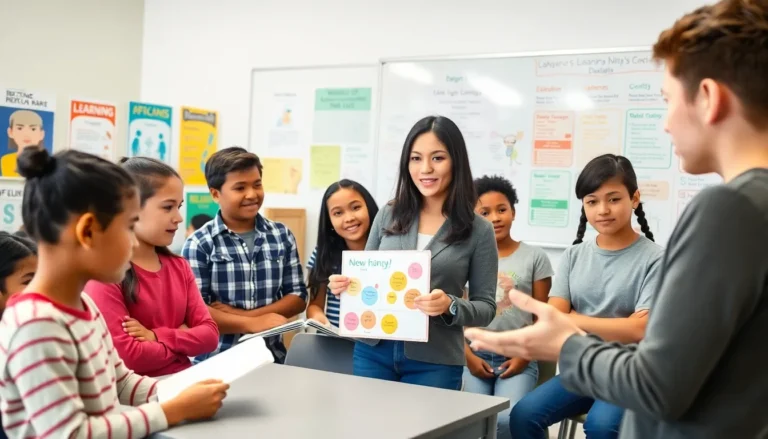Table of Contents
ToggleLearning about functions can feel a lot like trying to master a new language. Both involve a unique set of rules and structures that can initially seem intimidating. Just as one might struggle to conjugate verbs or remember vocabulary, grappling with functions can leave even the most determined learners scratching their heads. But fear not! There’s a light at the end of the tunnel, and it’s not just the glow of your computer screen.
Overview of Functions and Language Learning
Functions in mathematics and programming share similarities with language learning. Both involve mastering specific rules and structural components. Understanding functions requires recognizing input-output relationships, much like grasping subject-verb agreements or tense usage in a new language.
Learners often face uncertainties when tackling functions, paralleling their experiences with unfamiliar vocabulary. Over time, building foundational skills helps in both areas. Just as repetitive practice enhances language retention, consistent engagement with functions leads to deeper comprehension.
Complex concepts in functions, such as parameters and return values, resemble the complexities found in idiomatic expressions. Mastery of these elements needs patience and persistence. Each variable, similar to a new word, contributes to the overall meaning.
In language learning, communicative proficiency evolves through conversation and practice. Functions likewise benefit from hands-on application in coding or mathematical problems. Integrating both strategies fosters an environment of exploration.
Feedback plays a vital role in progress for both disciplines. Evaluating function outputs allows for adjustments, mirroring the feedback received in language practice. Constructive criticism accelerates development and boosts confidence.
Culminating knowledge in either field leads to fluency. Grasping functions opens doors to advanced mathematical concepts, while command of a new language unlocks communication opportunities. Both paths require time, effort, and commitment to achieve proficiency.
Key Similarities Between Functions and Language

Functions in mathematics and programming share key attributes with learning a new language. Both require understanding specific rules and structured components, which serve as the foundation for effective communication.
Structure and Syntax
Understanding structure represents a critical similarity between functions and language. Functions depend on precise syntax, including parameters and return values. Language also relies on grammar rules to form coherent sentences. Just as improper syntax in a function leads to errors, incorrect grammar alters the intended meaning of a spoken or written message. Mastering both structures entails recognizing patterns and adhering to established rules, providing clarity in either discipline.
Communication and Expression
Expressing ideas takes a central role in both functions and language. Functions facilitate data processing through input and output relationships, allowing computational communication. Similarly, language conveys thoughts through vocabulary and phrase construction. Both require practice to articulate effectively. Constructing functions and sentences with correct syntax enhances clarity. Engaging with feedback accelerates improvement, ensuring stronger communication skills develop over time.
The Learning Process
Learning functions and acquiring a new language share a distinct process. Both endeavors require foundational exposure before progressing to advanced concepts.
Initial Familiarization
Becoming acquainted with functions parallels the initial stages of language learning. Exposure to basic terminology and principles forms the groundwork for deeper understanding. In function learning, terms like parameters, arguments, and return values become essential. Likewise, vocabulary and simple sentence structures are critical in language acquisition. This early familiarization helps demystify both subjects, allowing learners to grasp fundamental components. Individuals often benefit from hands-on activities, such as engaging with simple functions or practicing basic phrases. Each small success fosters a sense of achievement, motivating further exploration.
Practice and Application
Routine practice plays a crucial role in both learning functions and mastering a new language. Regular engagement reinforces previous knowledge, solidifying critical concepts. Applying learned functions in programming tasks reflects how language learners utilize grammar rules in conversations. Each practice session reveals gaps in understanding, similar to struggling with complex phrases or function intricacies. Engaging in real-life applications enhances retention, allowing clearer connections between theory and practice. Both fields benefit from repetitive exercises, enabling learners to express ideas confidently. Success leads to improved proficiency, unlocking higher-level skills and deeper concepts.
Challenges Faced in Both Fields
Both learning functions and mastering a new language present distinctive challenges that can overwhelm learners. Navigating conceptual frameworks is a significant hurdle faced in each area.
Conceptual Understanding
Understanding functions requires grasping intricate concepts such as parameters and return values. This complexity mirrors the requirement to comprehend grammar rules and vocabulary in language learning. Learners often struggle to connect these ideas, leading to confusion. Misunderstandings may arise from overlooking foundational elements. Just as a student might misinterpret a sentence structure, a programmer could misuse a function’s parameters. Achieving clarity in both domains necessitates time, patience, and repeated practice, reinforcing foundational knowledge through engagement with material.
Common Mistakes
Mistakes often occur in both fields, primarily due to misapplying rules. Language learners might incorrectly conjugate verbs or misuse vocabulary, while programmers may mistakenly call functions with the wrong arguments. Such errors can hinder progression and induce frustration. Frequent repetition of incorrect information solidifies misunderstandings, complicating the learning process. Recognizing errors is vital for growth. In both disciplines, feedback plays a crucial role, guiding learners toward correction and deeper comprehension. Avoiding common pitfalls leads to successful mastery in functions and language alike.
Learning about functions and mastering a new language share fundamental similarities that highlight the importance of structure and practice. Both require a solid grasp of rules and syntax to effectively convey ideas. As learners navigate the complexities of functions or language, they encounter challenges that demand patience and persistence.
Engaging with feedback and continuously practicing are essential for overcoming obstacles in both areas. Just as one refines language skills through conversation, understanding functions improves with hands-on application. With dedication and time, individuals can achieve proficiency, unlocking the ability to express complex concepts with clarity and confidence.







